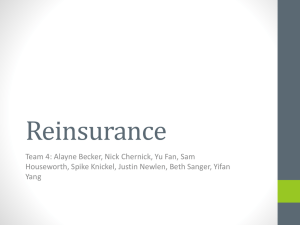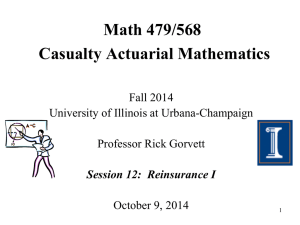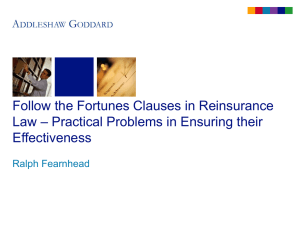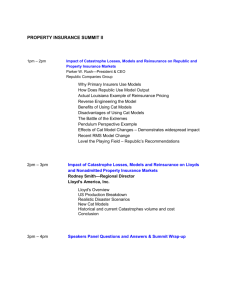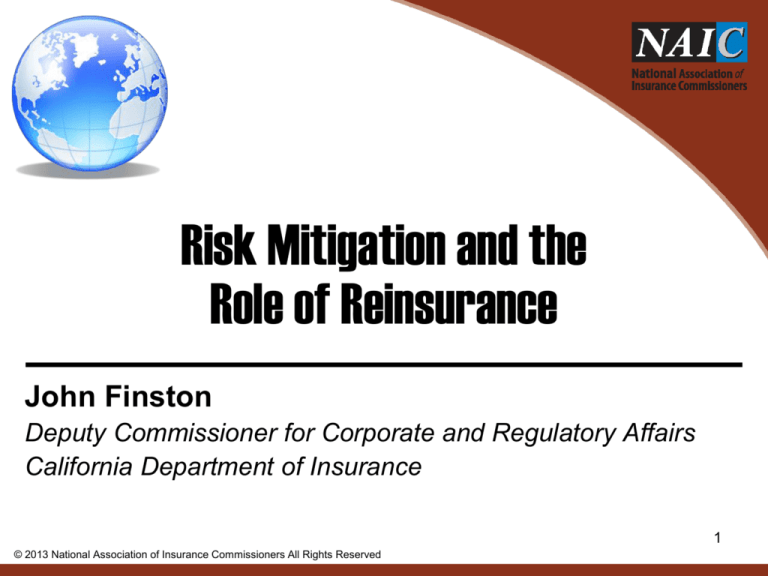
Risk Mitigation and the
Role of Reinsurance
John Finston
Deputy Commissioner for Corporate and Regulatory Affairs
California Department of Insurance
1
© 2013 National Association of Insurance Commissioners All Rights Reserved
Reinsurance
• Essentially “insurance for insurance companies”
• An insurer issuing policies becomes a “Ceding insurer”
in a reinsurance transaction when it transfers
insurance risk via a reinsurance contract to the
“Reinsurer.” If a Reinsurer enters into another
reinsurance agreement ceding its risk, its reinsurer is
called a “Retrocessionaire” and the contract is called a
retrocession agreement.
• Reinsurance is a form of insurance, not a lending or
money, that requires actual transfer of risk.
Risk Transfer
• Insurance risk transfer is the essential
ingredient of a reinsurance contract
• Under U.S. statutory accounting guidance,
insurance risk includes both:
– Underwriting risk – uncertainties about the ultimate amount of net
cash flows from premiums, commissions, claims and claim
settlement expenses
– Timing risk – the timing of the receipt and payment of those cash
flows
• Various analytical methods are utilized to evaluate
contracts for risk transfer
3
Advantages of Reinsurance:
Risk Mitigation / Insurance Risk Transfer
/ Financial Credit
• Maximizes spreading of risk to multiple insurers
• Insurers generally transfer insurance risk for one or
more of the following purposes:
–
–
–
–
Capacity
Catastrophe Protection
Stabilization
Financing
• Financial statement credit for reinsurance is
generally allowed if contract meets certain
requirements
Parties to a
Reinsurance Contract
Policyholder to
insurer is direct
premium
Ceded premium for
the insurer is
assumed premium for
the reinsurer
Policyholder
Direct
writer
cedes
Policyholder and
insurer
have a contract
(policy)
Insurer and
reinsurer
have a contract
(Reinsurance contract)
Reinsurer
assumes
Policyholder and reinsurer
do not have a contract
Property Casualty
Reinsurance
• Treaty vs. Facultative
• Proportional
– Quota Share
– Surplus Share
• Non-Proportional
– Excess of Loss
• Per Risk
• Per Occurrence (e.g., Catastrophe)
• Aggregate
Proportional Agreement Types
• Quota Share
– Simplest type, reinsurer and reinsured
share in premiums and losses at a fixed
percentage on a first dollar basis
– Example: Retention 60% / Reinsurance 40%
Policy Limit Retained 60%
Reinsured 40%
$100,000
$60,000
$40,000
$200,000
$120,000
$80,000
Proportional Agreement Types
• Surplus Share
– Greater flexibility, reinsured selects retention for each risk,
and cedes multiples of the retention (lines) to the reinsurer
– Compare ceded amount to policy limit. Create a proportion.
Reinsurer shares in that proportion of losses and premiums
applicable to the policy from a first dollar basis.
– Example: Retention $20,000
Policy Limit Reinsured’s Share Reinsurer’s Share
$20,000
100%
0
$40,000
50%
50%
$60,000
33.33%
66.67%
Non-Proportional Agreements
• Reinsured retains a predetermined dollar amount
(retention). Reinsurer then indemnifies loss in
excess of that retention up to a stated limit.
• Coverage is frequently provided in layers
• As the limits of the layer are exhausted, the next
layer of excess reinsurance becomes available
Types of Agreements
EXCESS OF LOSS REINSURANCE
Type of Reinsurance
Type of Loss
Single Loss
Exceeding Retention
Accumulation of
Losses in Single
Occurrence
Exceeding Retention
Total Net Retained
Losses Over Year
Exceeding Retention
Per Risk
Excess of Loss
Per Occurrence
Excess of Loss
Aggregate
Excess of Loss
Covered
Sometimes
Covered
Not Covered
Not Covered
Covered
Not Covered
Not Covered
Not Covered
Covered
Excess of Loss Contract
$ 10 M
95% of $5M xs $5M
$5M
95% of $4M xs $1M
$1M
$ 500 K
95% $500K xs $500K
Retention
Reinsurance Program Example
$ Loss
Catastrophe
2nd Excess
1st Excess
NonProportional
Surplus Share
Retention
Quota
Share
Proportional
Reinsurance Contract Basics
Proportional Reinsurance
Non-Proportional Reinsurance
Reinsurance
Contracts
Treaty
Pro Rata
Quota Share
Facultative
Excess of Loss
Surplus Share
Per Risk
Per Occurrence
Aggregate
Certificate
Semi Automatic
OR Automatic
Pro Rata
Excess of Loss
Other Considerations:
• Occurrence vs. Claims Made
• Prospective (future) vs. Retroactive (past events)
• Insurance Risk Transfer
Life Reinsurance
• Automatic vs. Facultative
• Proportional
– Yearly Renewable Term
– Co-insurance
• Modified Co-insurance
• Co-insurance with Funds Withheld
• Non-proportional
– Yearly Renewable Term can also be nonproportional
– Catastrophe
– Stop Loss
• Indemnity vs. Assumption
Yearly Renewable Term
• A form of life reinsurance usually covering only mortality risk
under which the ceding insurer buys coverage for the net
amount at risk on the reinsured portion of the policy for a
specified premium that may vary each year with the amount at
risk, the duration of the policy, and the ages of the insured(s).
• The ceding insurer retains responsibility for establishing
reserves and the payment of all surrenders, dividends,
commissions, and expenses.
• Despite its name, YRT reinsurance contracts typically obligate
the reinsurer to continue coverage throughout the life of the
policy.
Coinsurance
• A method of reinsurance under which the reinsurer
receives a proportionate share of the premiums, sets
up a proportionate share of the reserves and pays its
proportionate share of the benefits of the reinsured
policy.
• The reinsurer pays the ceding commission and
expense allowance to the ceding company to
represent the reinsurer’s share of the acquisition and
maintenance expenses.
Modified Coinsurance
• Indemnity life reinsurance that differs from
coinsurance only in that the assets supporting the
reserves are transferred back to the ceding company
while the risk remains with the reinsurer.
• The ceding company is required to pay interest to
replace that which would have been earned by the
reinsurer if it had held the assets corresponding to
the reserves in its own investment portfolio.
• Used to retain control of investments or to reduce
potential credit risk.
Reinsurance Analysis
• Adequate reinsurance cover
• Quality / financial strength of reinsurers
• Diversification / concentration of risk
• Affiliated reinsurance arrangements
• Proper transparency / disclosure in the financial
statements
18
Importance to Financial
Solvency Regulation
• Reinsurance significantly affects reported financial results,
reflected as an asset or a reduction of liability.
• Accounting and reporting differs significantly depending on
characteristics of reinsurance agreement;
• Ceding insurer maintains obligation to primary policyholder
regardless of whether reinsurer meets its obligations
• Contracts can be complex, subject to misinterpretation
• Successful insurance company management generally requires
high degree of reinsurance understanding
• Comprehensive analysis of a reinsurance program requires a
thorough understanding of the rights and obligations of each
party under the agreements
19
Captives
A special type of insurer that is set up by a parent
company, trade association or group of
companies in a common business that exclusively
insure the risks of their owner or owners
• Types of Captives
–
–
–
–
–
Pure (single parent captive)
Group
Association
Rent-a-captive
Special Purpose
Captives - Benefits
• Broader coverage through underwriting
flexibility
• Improved service through claims management
(greater control) and better risk management
• Potential Cost Savings
– Direct reinsurer access
– Investment income and capture underwriting profits
– Tax benefits
• Fewer regulatory restrictions
Captives - Risks
• From Company Perspective:
– Lack of diversification of risk and potential risk
concentration
– Dependence on service providers
– Internal administrative costs
– Capitalization and commitment
– Taxation issues
– Increased cost and reduced availability of other
insurance
• From Regulator’s Perspective:
– Potential loss of consumer protection & safeguards
– Lack of transparency
Reinsurance and
the Capital Markets
• Convergence of reinsurance and capital markets has
resulted in development of Hybrid Products and
Financial Instruments (Insurance-Linked Securities) as
alternatives or compliments to traditional reinsurance
• Convergence drivers:
–
–
–
–
–
Growth in insured values in catastrophe-prone areas
Reinsurance market inefficiencies/underwriting cycle
Advances in computing/communications technologies
Regulatory, accounting, tax and rating agency factors
Modern financial theory/deeper understanding of risk
management has facilitated financial engineering
Reinsurance and
the Capital Markets
• Property/Casualty
–
–
–
–
–
–
Catastrophe Bonds
Reinsurance Sidecars
Collateralized Reinsurance Investment
Industry Loss Warranties
Contingent Capital
Catastrophe Futures and Insurance Derivatives
• Life
–
–
–
–
Value in Force or Embedded Value Transaction
Reserve Funding
Extreme Mortality Bonds
Longevity Swaps
Impact of Quota Share
Quota Share 80%
Acquisition Costs 30%
Ceding Commission 35%
1 Year Contract Effective 6/30/XX
INCOME STATEMENT
--------------PREMIUMS WRITTEN
CHANGE IN UPR
--------------PREMIUMS EARNED
--------------LOSSES INCURRED
LOSS EXP.INCURRED
OTHER UND. EXPENSES
--------------UNDERWRITING DEDUCTIONS
UNDERWRITING INCOME
INVESTMENT INCOME
OTHER INCOME/LOSS
TAXES
NET INCOME
LOSS RATIO
NPW/Surplus
Commission Ratio
12/31/XX
80%
12/31/XX
Before
Q/S
After
Reinsurance
Reinsurance
Reinsurance
-------------------- ------------------------------ ----------------------------
10,000,000
4,000,000
-------------------6,000,000
-------------------3,000,000
550,000
3,000,000
-------------------6,550,000
-------------------(550,000)
250,000
(8,000,000)
(3,200,000)
-----------------------------(4,800,000)
-----------------------------(2,400,000)
(440,000)
(2,800,000)
-----------------------------(5,640,000)
-----------------------------840,000
2,000,000
800,000
---------------------------1,200,000
---------------------------600,000
110,000
200,000
---------------------------910,000
---------------------------290,000
250,000
0
365,000
-------------------- ------------------------------ ---------------------------(300,000)
840,000
175,000
=========== ================= ================
59.17%
59.17%
285.71%
46.09%
30%
10%
Impact of Quota Share
Balance Sheet
ASSETS
--------------INVESTMENTS & CASH
AGENTS' BALANCES
REINSURANCE RECOV.
MISC. ASSETS
TOTAL ASSETS
=======
LIABILITIES
--------------LOSSES & LAE
REINSURANCE PAYABLE
UNEARNED PREMIUMS
OTHER EXP. & TAXES
MISC. LIABILITIES
TOTAL LIABILITIES
CAPITAL AND SURPLUS
CAPITAL
UNASSIGNED SURPLUS
REINS.BEN.
POLICYHOLDERS' SURPLUS
TOTAL LIAB. AND SURPLUS
Ratio of liab. to surplus
12/31/XX
Before
Reinsurance
20,980,000
1,650,000
150,000
135,000
---------------------22,915,000
===========
80%
Q/S
Reinsurance
-5,200,000
15,250,000
450,000
3,500,000
150,000
65,000
---------------------19,415,000
----------------------
-2,840,000
-5,200,000
=
-3,200,000
-6,040,000
-
2,750,000
750,000
---------------------3,500,000
---------------------22,915,000
===========
554.71%
840,000
840,000
-5,200,000
=
12/31/XX
After Reinsurance
------------------------------15,780,000
1,650,000
150,000
135,000
------------------------------17,715,000
===============
12,410,000
450,000
300,000
150,000
65,000
------------------------------13,375,000
------------------------------2,750,000
750,000
840,000
------------------------------4,340,000
------------------------------17,715,000
===============
308.18%
Impact of Excess of Loss
Excess of Loss
$500k XS $500k
Reinsurance Premiums = 12% DPW
1 Year Contract Effective 6/30/XX
INCOME STATEMENT
--------------PREMIUMS WRITTEN
CHANGE IN UPR
--------------PREMIUMS EARNED
--------------LOSSES INCURRED
LOSS EXP.INCURRED
OTHER UND. EXPENSES
--------------UNDERWRITING DEDUCTIONS
UNDERWRITING INCOME
INVESTMENT INCOME
OTHER INCOME/LOSS
TAXES
NET INCOME
LOSS RATIO
NPW/Surplus
Commission Ratio
12/31/XX
12/31/XX
Before
After
Reinsurance
Reinsurance
Reinsurance
-------------------- ------------------------------ ----------------------------
10,000,000
(1,200,000)
4,000,000
(600,000)
-------------------- -----------------------------6,000,000
(600,000)
-------------------- -----------------------------3,000,000
(420,000)
550,000
0
3,000,000
0
-------------------- -----------------------------6,550,000
(420,000)
-------------------- -----------------------------(550,000)
(180,000)
250,000
8,800,000
3,400,000
---------------------------5,400,000
---------------------------2,580,000
550,000
3,000,000
---------------------------6,130,000
---------------------------(730,000)
250,000
0
0
-------------------- ------------------------------ ---------------------------(300,000)
(180,000)
(480,000)
========== =============== ==============
59.17%
57.96%
285.71%
265.06%
30%
34%
Impact of Excess of Loss
Balance Sheet
ASSETS
INVESTMENTS & CASH
AGENTS' BALANCES
REINSURANCE RECOV.
MISC. ASSETS
TOTAL ASSETS
=======
LIABILITIES
--------------LOSSES & LAE
REINSURANCE PAYABLE
UNEARNED PREMIUMS
OTHER EXP. & TAXES
MISC. LIABILITIES
TOTAL LIABILITIES
CAPITAL AND SURPLUS
CAPITAL
UNASSIGNED SURPLUS
REINS.BEN.
POLICYHOLDERS' SURPLUS
TOTAL LIAB. AND SURPLUS
Ratio of liab. to surplus
12/31/XX
12/31/XX
20,980,000
-1,200,000
19,780,000
1,650,000
1,650,000
150,000
150,000
135,000
135,000
---------------------- ------------------------- ------------------------------22,915,000
-1,200,000
21,715,000
=========== ============ ===============
15,250,000
-420,000
14,830,000
450,000
450,000
3,500,000
-600,000
2,900,000
150,000
150,000
65,000
65,000
---------------------- ------------------------- ------------------------------19,415,000
-1,020,000
18,395,000
---------------------- ------------------------- ------------------------------2,750,000
750,000
-180,000
---------------------- ------------------------3,500,000
-180,000
---------------------- ------------------------22,915,000
-1,200,000
=========== ============
554.71%
2,750,000
750,000
-180,000
------------------------------3,320,000
------------------------------21,715,000
===============
554.07%





